LEAD Conference Equips Adventist Church Leaders for Integration in Mission
LEAD Conference emphasizes theme, “Integration for Mission,” during Annual Council 2025. [Photo: Peterson Fagundes]
Annual Council 2025 attendees encouraged to integrate with God and others.
LEAD Conference provides professional development for global Adventist leaders and lay people who attend the Annual Council.
The program began with a devotional from GC Secretary Rick McEdward, who set the tone and spoke on “All for God and Mission”.
There were videos, case studies, prayer sessions, small group discussions, and breakout sessions, designed to help attendees think about what mission integration might look like in their own regions of the global Adventist church.
Justin Kim, Adventist Review editor, and Siku Daco, Adventist Review associate editor, host this year’s LEAD Conference during Annual Council 2025 in Silver Spring, Maryland. [Photo: Peterson Fagundes]
Justin Kim, editor, and Siku Daco, associate editor, both from Adventist Review, hosted the program and led participants through three segments in achieving integration.
Keynote speaker Tim Cook, chief integration officer at AdventHealth, began the morning by sharing how Adventist health care has achieved mission integration and the positive outcomes from that integration.
“Having a mission statement on the wall that isn’t really lived out in experience doesn’t really mean a lot,” he said.
The first section, “Integration with God for Mission,” included talks from Ted Levterov and Dwain Esmond, both associate directors of the Ellen G. White Estate, and David Hartman, professor at Southern Adventist University. There were testimonies from church leaders on how they study the Bible and pray.
The second block of programming highlighted the idea of integrating with others.
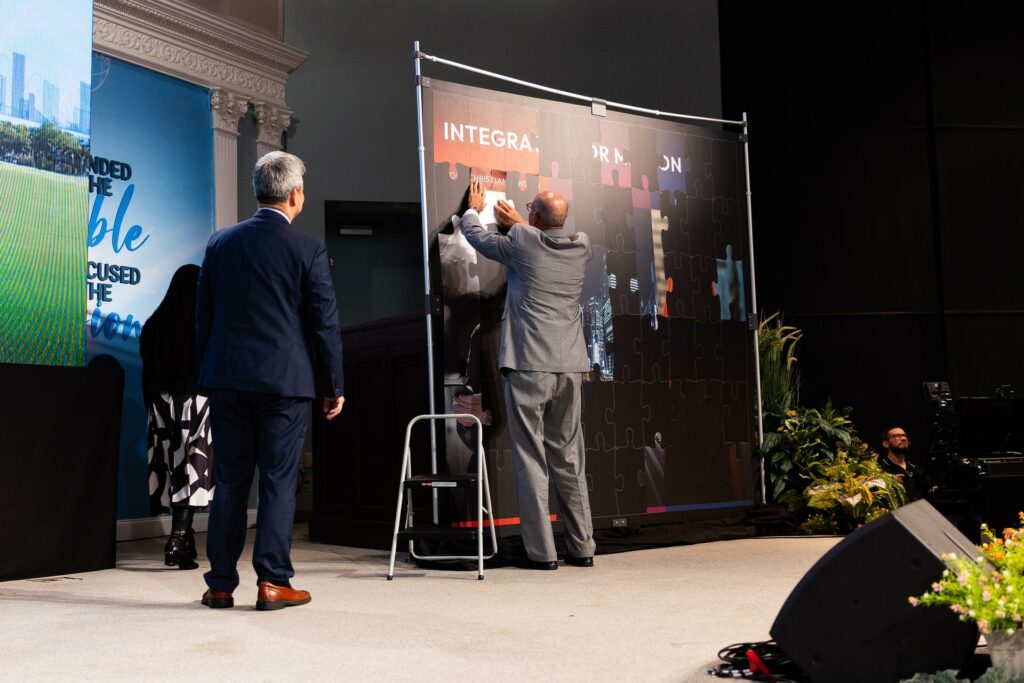
LEAD conference presenters add puzzle pieces to the “Integrated for Mission” puzzle. [Photo: Peterson Fagundes]
GC Associate Ministerial Secretary, Anthony Kent, shared on hospitality in the book of Titus.
“Relationships and leadership are not always easy,” he said.
Holding up an Arsenal football jersey, he reflected on the rivalry between his beloved team and their crosstown rivals, Tottenham Hotspur.
“Hosptiality for Paul is philoxenos—love of the stranger, love of the foreigner, love of the other,” he said. “In the ancient world, the word for stranger was often the same as the word for enemy. Paul knew from experience what the absence of love for others did. It had catastrophic consequences. For mission, it is essential that we love.”
![Marcelo Dias, associate director of Global Mission at the Southern Asia Division speaks about the Dehli Integrated Mission project. [Photo: Peterson Fagundes]](https://interamerica.org/wp-content/uploads/2025/10/lead3bx1760121373266.avif)
Senior Vice President of Strategy and Brand for Adventist HealthCare, Costin Jordache, spoke about how Adventist HealthCare was serving its community.
“The success of mission depends on the health of relationships,” he said. “Mission moves towards its destination along the tracks of relationships.”
He provided positive examples of how the hospital system, local churches, and the Pathway to Health program added value to local communities, which, in turn, facilitated easier relationships between institutions and community members.
“In order for us to create engaging relationships we must demonstrate our value to that community and to its unique needs,” he said.
The afternoon session contained reports from several case studies under the headline “Integrating in Action”. Presenters shared mission stories that highlighted collaboration across churches, institutions and territories.
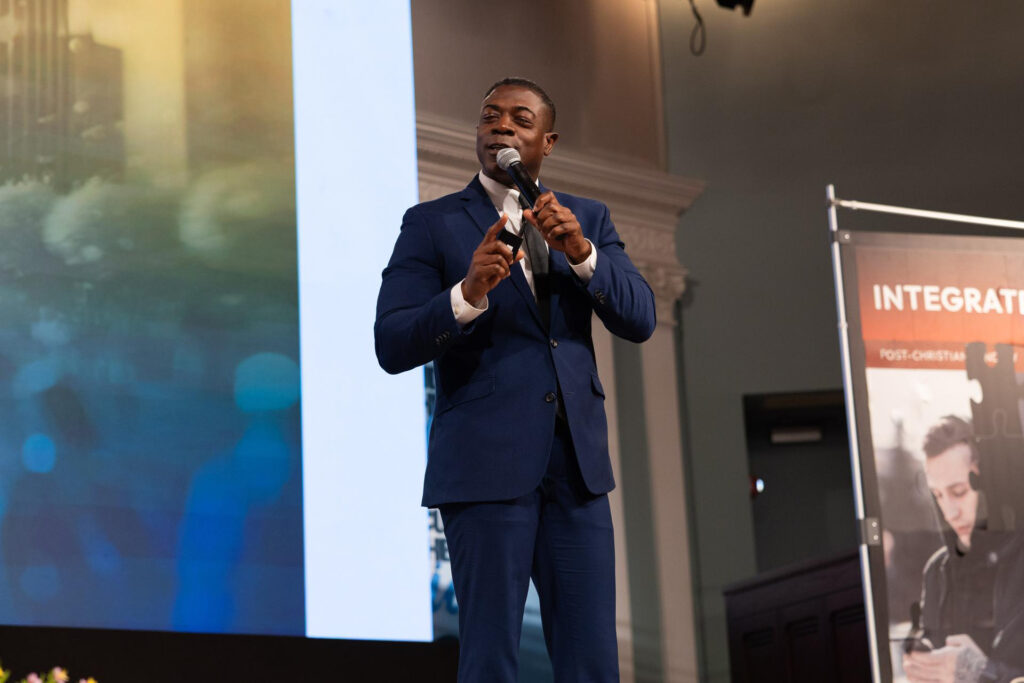
Dwain Esmond, associate director at the Ellen G. White Estate, presents during LEAD Conference in Silver Spring, Maryland. [Photo: Peterson Fagundes]
Some of the projects included the Youth Alive program, which includes many ministries uniting to build relationships and answer the questions young people are asking in places like Albania and secular European countries.
Marcelo Dias, associate director of Global Mission at the Southern Asia Division spoke about a project that integrates Adventist unions in West Central Brazil and Northern India for the Dehli Integrated Mission project.
He said the church must be “mobilizing everyone for global mission”, “teach and practice mission partnership principles” and “develop and follow integrative mission models.”
An Adventist school has been upgraded and supported through this program.
“The Noida Adventist School is a tangible symbol of shared vision meeting mutual investment,” he said.
ChanMin Chung, Global Mission Centers director, shares during the LEAD Conference at Annual Council 2025 in Silver Spring, Maryland. [Photo: Peterson Fagundes]
ChanMin Chung, Global Mission Centers director, shared about his Korean grandfather whose village was destroyed in the Korean War.
“Each family tired to rebuild their house but it was too much,” he said.
So Chung’s grandfather pulled together all the families who shared tools, labour and plans to help each other. He said, “Together they rebuilt 100 houses. We are here to build the house of God but we cannot do it alone.”
The final case study highlighted the Urban Life Centre in Baltimore, Maryland, United States, a community-focused ministry that promotes health, wellness, and healing.
Started by the Ellicott Seventh-day Adventist Church, in the Chesapeake Conference, in the United States, the project provides a safe space that provides a juice bar, language and health classes, and a space for connection. Baltimore White Marsh Adventist Church, on the other side of the city, soon joined the project, and together the churches minister to the community and partner, demonstrating integration in mission.
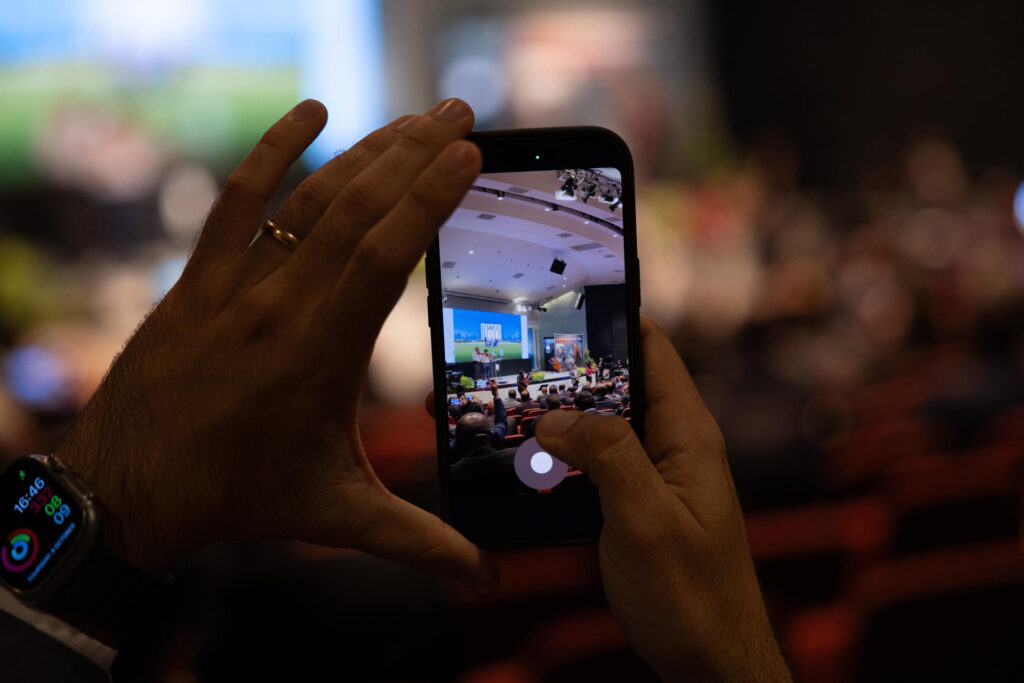
Delegate records as flash mob takes place during LEAD Conference. [Photo: Peterson Fagundes]
Finally, Vyacheslav Demyan, Hope Channel International president, shared about the Hope Centers in the Inter-European Division that are integrating to share hope with local communities. One of those centers, in Wasserburg, Germany, is serving approximately 150 people every day.
Attendees were able to attend breakout sessions during two afternoon sessions, which contained more details of some of the mission projects that had been highlighted throughout the day.
After the breakout sessions, when delegates came back together, McEdward took to the stage to issue a final challenge.
He said, “In every way today, we’ve looked at integrating with God for mission.”
As McEdward summarized the day, a sharp foghorn sound blew through the auditorium GC auditorium. Although McEdward continued, this was followed by a few more random notes, before he was interrupted by a lone saxophonist playing the hymn “I surrender all” and walking down the centre aisle. He was joined by a strumming guitarist.
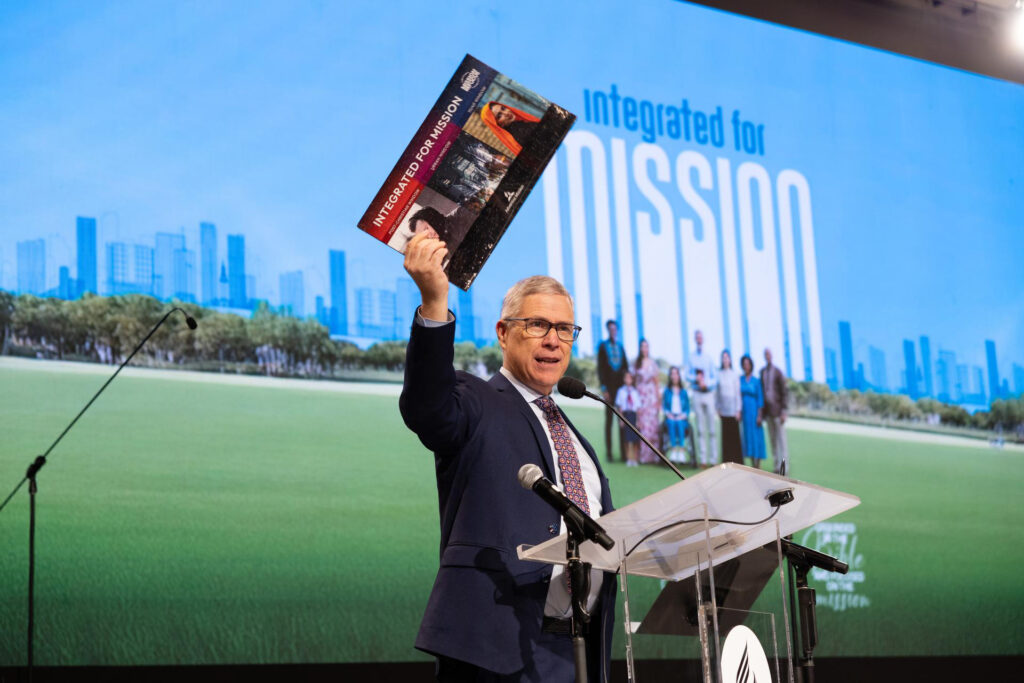
Rick McEdwards, General Conference Secretary, emphasizes the need for unity in mission [Photo: Peterson Fagundes]
Then strings were added as all the musicians came from various parts of the auditorium accompanying, their melodies “integrating” into one, instrumental rendition. More musicians were added until there was a full band and the medley continued with “Side by side we stand”. Soon singers joined with “We are His hands”, before inviting the audience to join them.
“Music is like integration,” said Erton Köhler, GC president, who entered the stage as the musicians finished their medley. “If you’re alone, it can be good, but together things can be better.”
He then extended an invitation to the attendees.
“As the Seventh-day Adventist Church we are not islands, we are a body. Our call is to be a body where everything is connected, and we can move forward together.”
With a final prayer, this year’s LEAD Conference concluded.